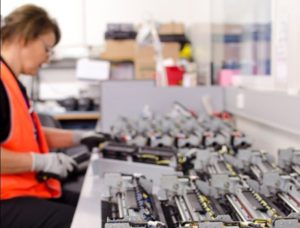Tooling up to manufacture a circular economy
 James Griffin leads the Sustainable Business Network’s Circular Economy Accelerator (CEA) to hasten the adoption of a circular economy in New Zealand. He says the challenges awaiting manufacturers are both significant and exciting.
James Griffin leads the Sustainable Business Network’s Circular Economy Accelerator (CEA) to hasten the adoption of a circular economy in New Zealand. He says the challenges awaiting manufacturers are both significant and exciting.
Circular economy thinking is already producing real world tools to change the way we make things. In the process we could remake our world.
We need a fundamental transformation in design, manufacture, procurement and supply chain management. Otherwise humanity will find itself pumping waste and pollution around its economic system for aeons to come.
The principles of this shift are well-established. If we are going to design the waste and pollution out of our way of life, all products need to be designed for longevity. They must incorporate the ability to repair, upgrade, reuse and disassemble them.
And at the end of their life precious materials must be harvested and re-cycled in closed loops. This requires careful design thinking from the outset and throughout the manufacturing process. Otherwise we tend to lock ourselves into linear pathways and approaches.
Think renewable energy. Think recycled and recycled materials. Think manufacturing for leasing and product stewardship rather than sale and disposal.
The potential benefits of this approach have been clearly identified. And they are enormous. In May we released a ground-breaking economic study completed by Sapere Research Group in partnership with ATEED. We discovered that Auckland could be up to $8.8 billion better off in 2030 if the city adopted a circular economy approach.
To make this happen, and reap the rewards, leading manufacturers will need to partner with system thinkers and academic institutions. This is what is driving the development of the CEA’s Institute for Innovation in Remanufacture & Reuse.
Once established, this will bring together business people and academics, working together to address the many technical and systemic challenges around remanufacture, repair or reuse.
Businesses will also need to work together. We have to meet individual business challenges and overcome the systemic barriers to progress.
For this, CEA is currently bringing companies together into its Circular Innovation Programme. We have an initial systems diagnosis of key New Zealand business sectors is already underway. This will help identify the nature of the challenges ahead.
If you want to get hands on straight away with existing methodologies and tools for the implementation of closed-loop manufacturing systems, check out ResCom – Resource Conservative Manufacturing. This helps designers and manufacturers understand how collection, remanufacturing and reuse of products can lead to more profitable, resource-efficient and resilient business practices. It comes complete with industrial case studies demonstrating the benefits.
We hope to begin translating resources like these to make them more directly applicable for New Zealand manufacturing in the near future. We will also be producing new tools and resources to assist manufacturers in making this shift.
This kind of manufacturing will be increasingly demanded by business-to-business customers and brands, as well as consumers themselves. It represents the most effective and efficient way to continue to meet the needs of the marketplace, without undermining the resource base it relies on.
Already governments and policy makers are moving to bring manufacturing into this kind of framework. The EU Commission has adopted an ambitious Circular Economy Action Plan.
China has incorporated new laws to explicitly promote the Circular Economy into its five year plans. The resulting shut-down of waste importation to China has radically reshaped the market for waste materials. Other changes will soon materially affect manufacturing for export to and import from these areas.
So now is the time to get up to speed on this idea. It is set to radically transform the manufacturing sector in the months, years and decades to come.



